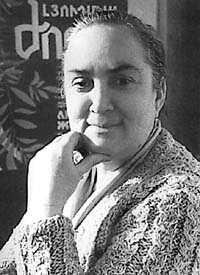Artist’s Portrait In Tapestry

Liudmyla Zhohol is a People’s Artiste of Ukraine, member of the Ukrainian Academy of Architecture, Candidate of Science in art studies, participant in a large number of exhibits, including foreign ones. She has dedicated over forty years to decorative textiles. Without doubt, she is a strong, active, fulfilled person. In her works sentimental overtones subtly combine with a definite touch of grandeur. Looking at her, one is reminded of a Georgian princess.
Features about artists are traditionally dedicated to jubilees or the opening of an exhibit. In the case of Liudmyla Zhohol, both happened last year. So another year has been added to her creative biography and vast creative heritage without any ado or eulogies.
Ms. Zhohol’s creativity represents an entire layer of hand-weaving culture. She is a tapestry wizard, her skill was highly praised in the seventies and eighties. To better understand the artist’s innovation, it seems worth making a few digressions into the past.
Ukrainian folk Gobelin tapestries are pileless carpets developed in the eighteenth century, and it was on that creative basis that the craft revived in the 1960s. Historically, however, the two periods were linked by a period of the so-called thematic carpet (1930s-1950s) focusing on the pictorial aspect. Noted artists Rokytsky, Shavykin, Derehus, Petrytsky, et. al. , dedicated their pictures to social and political subjects. The pictures were then accurately reproduced in tapestries, thus leveling off the artistic properties of both painting and tapestry weaving, and no one ever considered that the tapestry’s future was as interior decoration.
Liudmyla and I sat in her spacious brightly lit studio. I was aware that facing me was a living classic, yet her charming personality created an easy atmosphere.
An international artistic textile center opened in Lausanne (Switzerland) in 1960, whereupon biannual exhibits started being held. The center specialized in various modernist and postmodernist trends. Liudmyla often participated in the prestigious biannual, yet her credo remained the same: synthesis of folk art with modern interior design. This was what nourished her innovative talent. In her works she combined the image-bearing logic of the Ukrainian folk carpet, plakhta skirt, embroidery, classical French Gobelin, and modern Picasso and Lurcat weaving techniques.
Her creative path in the world of ornamental textiles has always been linked with architectural space. For a long time she headed the monumental textile art laboratory at Kyiv’s Zonal Standard and Experimental Housing and Public Design Institute. Kyiv Hotel was the first big and complex commission she worked on in the 1970s, as a member of the interior decoration team even at the design stage.
The hotel was regarded as ultramodern at the time. She initiated and actively participated in the creation of interior reflecting the nation’s specifics. The unity of all the decorative textile elements — veret multicolored coverings, curtains, tablecloths, and Gobelin tapestries — created a homey interior, an atmosphere which is still there. In fact, she believes that a rational approach to the hotel interior will attract foreign tourists. Incidentally, the same principle is utilized in the Hilton chain. Regrettably, the current trend in Ukraine places more emphasis on standard aesthetics. Liudmyla’s creative effort has been precisely the opposite, so her experience, currently mostly forgotten, is very likely to revive soon, and we will reach the world standard of construction design and amenities, yet with our own national elements conspicuous in interior decoration.
Zhohol’s talent is singular in that she is simultaneously a practitioner Liudmyla showed me her works, and theoretician. She is the author of several books and a multitude of articles, mostly about art synthesis and the role of decorative applied art in interior decoration.
She has perfect command of all ornamental textile techniques owing to her years of study at Lviv’s Institute Applied and Decorative Art and lifelong self-improvement. It is, however, traditional in Ukraine for a decorative applied artist to be most actively involved with production, with the end result being entrusted to skilled workers. Liudmyla’s tapestries are made by a factory in Reshetylivka (still proudly bearing the name of Comrade Clara Zetkin). The factory’s long-time manager and enthusiastic supporter is L. S. Tovstukha, and its survival under the current drastic economic situation (when many similar enterprises have long been closed) is largely due to his tireless effort.
Her current tapestries are mostly dedicated to flowers, akin to easel painting in terms of composition and size. Each would do justice to a private home interior. She says that the elite art of hand-woven tapestries is no longer in vogue, yet paradoxically modern interior decor remains a fashionable topic. In Ukraine, national decorative applied motifs remain practically excluded from private home interior aesthetics, more often than not replaced by expensive imported consumer goods. Since olden times, works of applied decorative art has set the tune of household, turning each dwelling structure into a cozy home. offering curious commentaries like “this tapestry called ‘Thistles Are My Flowers’ resembles me by character; and this is ‘Winter’ with a group of birds below symbolizing members of my family.” Looking at the tapestries lining the wall, I felt they were actual inhabitants of the studio, their home, living with the artist who made them .






